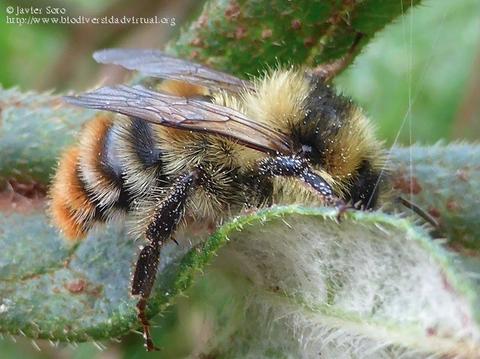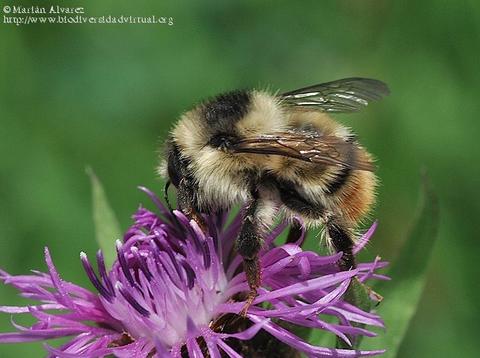Bombus sylvarum
Bombus sylvarum is a medium-small size. (Females: 16-18 mm; males: 12-14 mm)
Female: small size, with a long head. Conspicuous clypeus, longer than wider with a thin and dense stipple. Shiny forehead, with unspotted zones well defined. On the hind legs, convex tibia, without crosslinked appearance. Genitalia with external projections of the stinge's case wide, the internal ones also are wide.
Yellow colour, with a grey-green tone in most of the body surface. Face, vertex and torax of a pale yellow-green colour. The last segments are red coloured. Legs with hair of a yellow-red colour.
Male: small size. Long head. It shows a jaw with beard long and dense. Clypeus thin dotted at the discus. Genitalia with hooked sagittae, without central black tooth. The coloration is similar to that of the females, with yellow and black stripes.


The queens emerge at April. The nest is built in the floor, or just below surface, sheltering it behind grass. The colonies aren't big, and the flight period goes from April until October. It prefers meadows in opened areas or forest areas. The forest can be of Pinus, Quercus or Fagus.
Female: small size, with a long head, due to its malar gap slightly larger than its distal wide (aproximately like A3+4). The malar gap has a thin and dispersed stipple. Conspicuous clypeus, longer than wider with a thin and dense stipple. The apical impressions are wide and well defined. Labrum's tubercles are rounded. Labrum's groove shallow and dilated. Labrum's sheet very shaped at the edge, like a knife. Shiny forehead, with unspotted zones well defined. On the hind legs, convex tibia, without crosslinked appearance. The basitarsus is provided of short and a bit dense pubescence. Genitalia with external projections of the stinge's case wide, the internal ones also are wide.
Yellow colour, with a grey-green tone in most of the body surface. Face, vertex and torax of a pale yellow-green colour. The band between the wings is black, but the edges aren't well defined. T1 is yellow, like T2, but this one with some black lateral hair, so it can seem darker. T3 black, with some yellow hair mixed. The last segments are red coloured. Legs with hair of a yellow-red colour.
Male: small size. Long head, due to its malar gap longer than the distal width. It shows a jaw with beard long and dense. Clypeus thin dotted at the discus. Last antenna's flagellomeres widened at the base. Elongated basitarsus with parallel sides. On the hind legs, the tibia is convex and not too much shiny. The basitarsus is width, with parallel sides too. T6truncated. Genitalia with hooked sagittae, without central black tooth. Prolonged squamas in a tooth, relatively long and narrow, and other later narrower. The coloration is similar to that of the females, with yellow and black stripes.
Bombus sylvarum is widely distributed in the West-Palaearctic region. It may be quite common and in some places, it is the predominant bumblebee species. West, its range extends in the Iberian peninsula to the parallel of Madrid. It is present in England, Wales and SE. Ireland but completely absent from Scotland. North, it extends in Fennoscandia to the 63rd parallel and in Russia to the 60th parallel. East, it hardly extends beyond the southern part of the Ural Mts., to Cheliabinsk. South-east, B. sylvarum is present throughout E. Anatolia, where it is present as its steppic daghestanicus form, in the Caucasus, Georgia, Armenia and NW. Iran. In the latter country, it does not reach the Mazandaran region. In the southern part of its range, B. sylvarum is clearly a montane species. It reaches the Etna in Sicily and the Taurus and Amanaus in Anatolia. In the Balkan, its limits are more northern : the mountains in N. Albania, Macedonia, Bulgaria and Pindos Mts., in N. Greece. It is absent from the large Mediterranean islands (except Sicily) and from N. Africa.
Potential distribution map at the present time
Potential distribution map in 2050 with the same level of pollution emission and the climate changes consequence of these contamination levels
Map legend
Maps are made with GBIF data of this specie in Iberian Peninsula